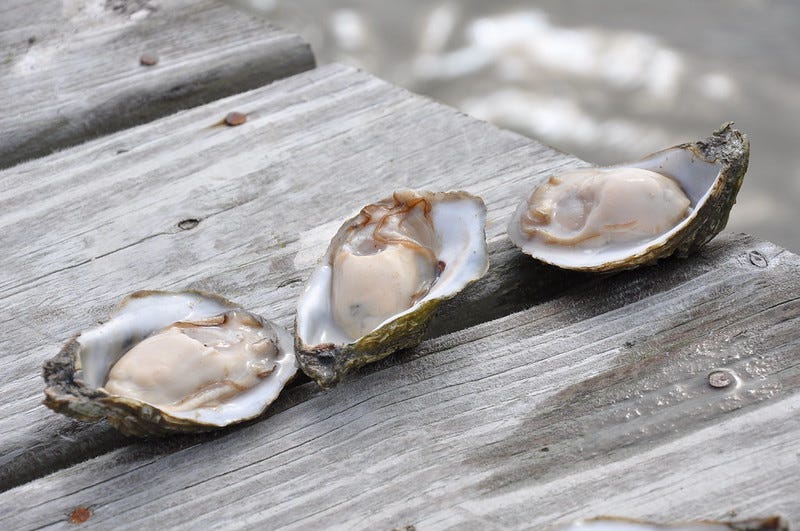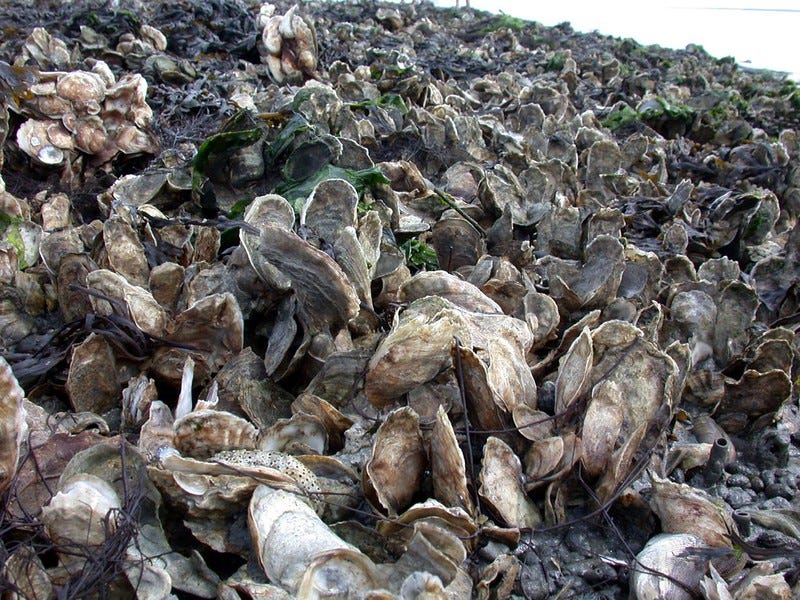
We are the bold. We are the oyster eaters.
Late last year, while this newsletter was on break, Texas-sourced oysters made hundreds of people across the South ill. Tests indicated the presence of norovirus, which tends to prompt what we call “stomach flu.” And how does an oyster come to carry norovirus? Generally by being doused in untreated human sewage.
Nonetheless, last week I convened a group of writer friends to feast on raw Gulf oysters.
“We have to love oysters,” Rick Bragg once said of male writers, mocking some of our ritualistic behaviors. “We have to sit around a table in some sun-blasted shack on some desolate, mosquito-infested cay and slurp ’em right out of the shell. Or they take our vowels away.” In our case, the setting was a dimly lit New Orleans restaurant whose white-table-cloth pretensions were undercut by the white sheet of paper on top, presumably supplied to make the post-savaging cleanup easier. As we slurped, we discussed this predilection. There is the thrill of eating a still-living being, an embrace of virility; or perhaps it was the chance to accumulate stacks of shells and rows of empty glass bottles, artifacts that attested to our conquest. Perhaps it was the forbidden nature of the oyster itself. The risk.
Early European sailors bemoaned the abundance of oysters that lined the Gulf of Mexico: they seemed to form a jagged wall at the mouth of every river, blocking entry to this coast. It’s an abundance that still fuels the industry today. Yes, Oysters are eaten across the country, but the Gulf of Mexico provides the bulk of the supply: 12.5 million pounds in 2019, according to NOAA, 45 percent of the national haul, most of which comes from Louisiana.
On a per-bivalve basis, Louisiana’s crop is among the country’s least valuable. Though oyster spat are “planted” by producers, the standard setting here remains ocean-bottom beds—closer to wild conditions than on most other oyster farms. Growth is less controlled, so the shells are harvested in various shapes and sizes, often far larger than your delicate Yankee oyster eater enjoys. This also means that rather than some cute name that indicates a specific provenance, they’re sold as “Gulf oysters,” a bulk, commodity product.
Despite the many names, all of the oysters in the South—all of the oysters found along the Gulf and Atlantic coasts—belong to a single species: Crassotrea virginica, the Eastern oyster. (Along with the Olympia oyster, it’s one of two oyster species native to the U.S., though other species have been introduced on the West Coast.) Given its clean taste, its ability to fully embrace the terroir of the local waters, the Eastern is, according to oyster expert Rowan Jacobson, “the oyster against which others should be measured.”
So what is the terroir of these muddy Gulf waters? M.F.K. Fisher, the forever queen of food writing, was disdainful. Not that she ever turned down an oyster, but in her 1941 book Consider the Oyster, she admitted that as you head further south “oysters grow less interesting served in the shell, and almost cry out for such delicious decadence as horse-radish or even cooking, which would be sacrilege in Boston or Bordeaux.” And this was three decades before anyone knew of Vibrio vulnificus. Vibrio, far more than the norovirus, dominates the dark story of Gulf coast oysters. It’s Vibrio that prompts many northern oyster bars to forbid these wild-growing brutes. Vibrio vulnificus is a “flesh-eating bacteria,” as the newspapers often put it, that thrives in warm and muddy waters.
I’m fairly confident I contracted a bit of vulnificus a year ago, thanks to my decision to shuck and slurp a sack of oysters without pausing to properly scrub off the layer of Gulf silt. I survived, obviously, but not without enduring a long, unpleasant evening. Those with compromised immune systems would have fared much worse: this little bacteria can be deadly. One study I consulted while researching this essay indicated that in samples of Gulf oysters harvested in warm months—May through October—every single specimen was infected with Vibrio.

Every bit of writing on oysters is required by literary law to quote Jonathan Swift: “He was a bold man,” the satirist wrote, back in 1738, “that first ate an oyster.”1
I, however, am not convinced. The ancient shell middens that sprawl along nearly every coastline suggests that people knew food when they saw it. The problem today is that oysters reflect terroir, and the terroir of the ocean is increasingly, everywhere, the taste of taint.
Already in Swift’s Dublin, sewage was dumped directly into the River Liffey, to be carried to the bay. Though the waters of the young U.S. were not much cleaner, still there was a nineteenth-century “oyster craze.” Every fancy party had to offer half shells; these little lozenges of flesh were available in bars and lunchrooms and carried door-to-door by salesmen. By the dawn of the twentieth century, after sewage-doused oysters began to kill diners, the appeal began to wane. The industry has been reformed since then, obviously, but the dark reputation remains.
The oysters in the Gulf of Mexico face a range of challenges. Less fresh water pours out of many rivers, leaving the bays much saltier than before. The Deepwater Horizon disaster in 2010 coated many oysters in oil. Overharvesting is an issue, too. Even before the norovirus outbreak last month, Texas closed several reefs. In Alabama, too, certain beds were closed. Florida’s Apalachicola Bay, once famed waters for oysters, is in the midst of a five-year ban.
It’s not clear how long Vibrio has plagued our waters. Some doctors believe that Hippocrates may have described an infection back in the fifth century, in the Aegean Sea, but Vibrio vulnificus was not a known species until the 1970s. Tightened regulations have helped reduce the risk; oysters harvested in the summer months must be refrigerated within an hour of harvest, for example.2 The long-term trend, though, is not encouraging: climate change is going to make the Gulf warmer, expanding the danger months, and will carry Vibrio further north. Even if we clean our coastal waters, then, the ancient tradition of oyster-eating is going to have to change to cope with our new environment.
The good news is that since this bacteria is killed by heat, you can enjoy your oysters fried—or chargrilled, and, in fine New Orleans style, doused in butter and spinach. Lately, too, there are more and oyster farms in the Gulf, where the bivalves are raised in floating cages—where, happily, oysters are less likely to become infected. The raw bar tradition will live on, then. Though oysters as a cheap bar snack, fifty cents a shuck, may be one more loss to our changing climate.
Oyster basics
Frankly, after researching this essay, my oyster behaviors have changed: I’m going to avoid raw Gulf oysters in the warmer months. Sure, my body seems capable of warding off Vibrio, why take the risk? Even in the cold season, if I see poorly washed oyster shells, I’ll be sending ‘em back.
The taste of your oysters will vary by season; they tend to be sweeter in spring and summer, when the Mississippi and other rivers bring more fresh water in the Gulf. They’ll be a fatter then, too.
There’s no wrong way to eat an oyster, but if you’re gonna bother with fresh, you want to taste the thing right? While I’ve used the word “slurp” throughout the above essay, since the Eastern oyster is a rather clean slate, to taste much terroir, you may have to chew.
Looking to dive deeper into this world? Check out Garden & Gun’s guide to oysters from each Southern state. And if you want to get out and see how it all happens on the water, consider joining Tesvich Oyster Tours.
I’ll note that when I tried to fact-check this quote, which appears in Fisher’s Consider the Oyster, I saw enough varied versions to wonder if it’s apocryphal.
Another option: The “hydrostatic pressure process,” in which oysters are subject to intense pressures for a bit more than a minute, killing most of the bacteria—and, conveniently, shucking the shells. The problem? The process also kills the oyster, which, though it remains edible, seems to lose some je ne sais quoi, at least according to the taste testers at the Washington Post. I’ve also never seen such oysters for sale in restaurants.




